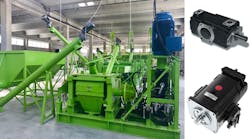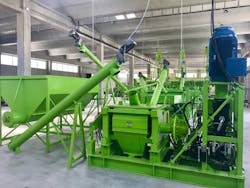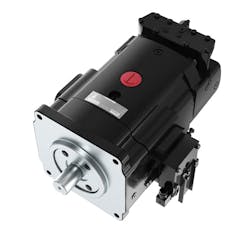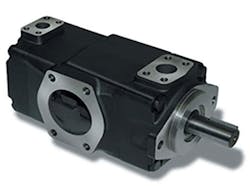Content has been updated as of Oct. 13, 2021.
Crumb rubber and rubber powder made from recycled tires are in growing demand for use in artificial turf, playground surfaces, pavement and other applications. In the recycling process, a cracker mill turns the rubber in recycled tires from which steel and tire cord are removed into smaller “crumbs.” In the mill, two corrugated rolls operating at different speeds crush and grind the rubber into particles. Current cracker mills have a fixed or narrow range of these speed differentials, known as friction ratios, and this limits their ability to turn out enough of the material with the right level of quality and size.
To overcome these limitations, engineers at Eco Green Equipment, a tire recycling equipment
manufacturer in North Salt Lake, Utah, developed the Krumbuster. It’s a hydraulically powered cracker mill designed to crank out up to 4,000 lb of crumb rubber per hour in sizes smaller than 6 mesh. (Mesh is the number of holes in a screen per linear inch.) With the same setup, it can also produce up to 2,000 lb per hour of 30 mesh rubber powder. It hits these goals while using up to 35% less horsepower than traditional mills and occupies a smaller footprint. Hydraulic power lets it respond quickly to changes in friction ratios, high shock loads and constantly changing pressures, including pressure spikes.
Traditional cracker mills have a separate mechanical gearbox and motor driving each roll; their friction ratios are fixed by the gearboxes. Some of these machines incorporate variable frequency drives to adjust the friction ratios, but this prevents them from maintaining full torque throughout their speed range.
The Krumbuster uses individual Parker Gold Cup hydrostatic piston pumps to power identical Hägglunds hydraulic motors mounted directly on the roller shafts. Each pump’s flow rate can be adjusted to provide the exact speed differential needed between the rolls. Typically, one motor may be running at 110 rpm while the other is at 3 rpm.
The higher speed motor is driven by a P24 Gold Cup pump, with a maximum displacement of 24.60 in3/rev. The lower speed motor relies on a P6 Gold Cup pump with a maximum displacement of 6.00 in3/rev. In addition, a three-section Parker T6 vane pump generates up to 250 psi to supply make-up oil to the other pumps and motors in the closed system. This replaces oil lost through designed-in leaks that lubricate the component’s hydrostatic bearing surface, as well as providing oil flow through the heat exchanger. The vane pump circulates about 50 gpm of fluid from the low side of the loop through the heat exchanger and filtration to provide cooler and cleaner oil to the two piston pumps. Eco Green says the pumps were chosen for their reliability, responsiveness and the ability to handle the high shock loads the process creates.
The two piston pumps have bearings centered around the barrel instead of conventional roller bearings supporting a large diameter shaft. This lets the main shaft have a smaller diameter, and the rotating pistons can be located closer to the center, lowering fluid velocity and generating more flow for speeds up to 3,600 rpm.
With hydraulically driven rolls, the Krumbuster delivers full torque at all speeds and uses 25 to 35% less horsepower than traditional mechanical designs. The manufacturer says that the speed differential between the rolls means the slow-roll piston pump receives flow from the slow-roll motor, providing energy that assists the machine’s electric motor in driving the larger pump. All three pumps are assembled and connected at the same time. They are driven by a single electric motor.
The Krumbuster’s output is 50% higher than the closest traditional cracker mill when making 30 to 60 mesh crumb rubber, according to Eco Green. Compared to a mechanical drive, the hydraulic version needs little maintenance and is more energy-efficient because it recovers energy from the slow roller. The pumps also allow nearly infinite adjustment of the friction ratios so the rolls can be calibrated to suit the material being processed and the desired particle output size. They provide constant torque at all friction ratios and can be started under load, so the rolls don’t have to be cleaned out before starting the machine.
Ray I. Scroggins is a contributing editor.




